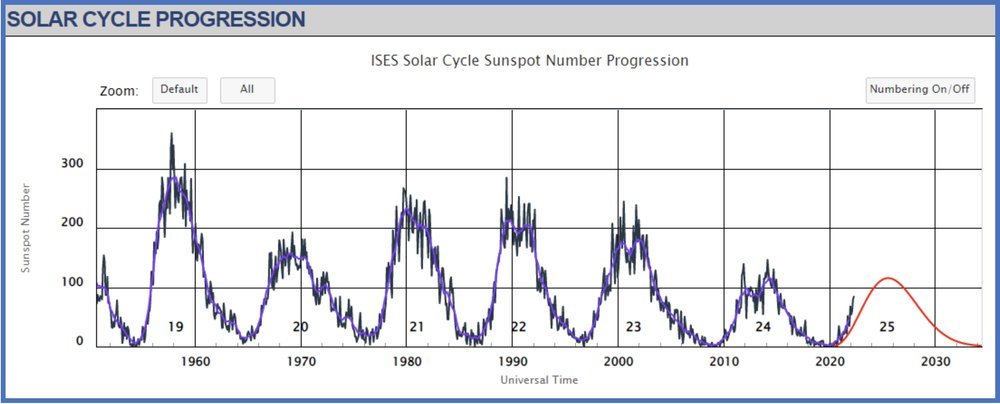Solar Cycle 25 and its Potential Impact on Wildlife Behavior
By Tim Harvey
MOSS FIELD NOTE #3
Due to a lifelong interest, I follow astronomy news. During the first months of 2022 and coinciding with the MOSS Master Naturalist course, I read repeated news stories about the recent unexpected increase in solar activity. Due to the importance of the sun to all life on earth, I wondered whether this activity might have some direct impact on wildlife behavior. I also wanted to observe some of this activity myself.
For reasons that are not yet clear to astronomers, solar activity tends to follow an 11-year cycle, though the exact cycle length has ranged from nine to thirteen years. The sun’s magnetic poles actually switch every cycle. This cycle has been established by carbon dating to have been continuous for at least the last 700 million years. It is a very stable cycle. According to this cycle, we should presently be emerging from the cyclic low in December 2019 and headed for a peak in 2025. However, recent solar activity (flares, coronal mass ejections, and sunspots) are unusually high for this point in the cycle.
Some scientists believe that solar activity also follows a longer roughly 100-year super-cycle, with our current cycle 25 also corresponding to a low in the larger cycle. As a result, Cycle 25 was expected to be very mild, but at least at this stage, solar activity is more robust than predicted.
The average solar storm (sunspot) is 2,500 times the strength of earth’s magnetic field. At maximum, over a hundred sunspots can exist simultaneously. By comparison, at the low part of the cycle, close to zero sunspots often exist, creating minimal electromagnetic disturbance.
Prior to looking into this, I thought perhaps there would be some loose or spotty evidence about a possible connection between solar activity and wildlife behavior. But in fact, it is thoroughly researched and documented, and there are a number of known impacts on life on earth:
Impact on Life on Earth
The 11-year cycle has been associated with numerous impacts on animal behavior. For example:
Solar cycle is documented via Carbon 14 in tree rings and via Beryllium 10 (from cosmic rays) in ice cores;
Bird egg laying timing tends to be one to two weeks earlier in years with high solar activity;
Porcupine, hare, shrew, and vole (most prevalent mammals in the geographic region of each study), with implications for all mammal populations;
Cloud cover and therefore winter precipitation are higher during solar cycle highs, which may also be the causal mechanism for mammal populations and other biological effects;
There is a weak and inconclusive association with insect outbreaks;
Beached whales and crustaceans are more numerous during periods of high solar activity;
Bird migration and directional accuracy is disrupted during solar maximums, especially for species that fly at night;
Stream flows are higher in periods of high solar activity, probably due to the cloud cover and precipitation effects;
The causation of all of the above effects is likely magnetic but could also be related to cosmic radiation or solar heat output, both of which also increase at solar maximum.
Impact on Human Society and Health
High solar activity could disrupt communications and society;
The “Carrington Event” of 1859, a large solar event, disabled telegraph activity worldwide and permanently damaged telegraph equipment;
During the Carrington Event, telegraphs caught fire, operators were electrically shocked, and telegraphs worldwide, and this is documented in numerous accounts, were able to operate without being hooked up to electricity.
During the Carrington Event, the Aurora Borealis could be seen as far south as Southern Mexico and Hawaii;
A similar solar event today would likely disable significant portions of our electronic society, including satellite communications, cellular communications, and potentially even data storage used by financial institutions.
There is a strong association between solar activity and heart attacks (myocardial infarctions), probably due to the heart’s electrical activity, which drives heart rhythms and overall heart function.
Observational Techniques for Naturalists
It might seem that expensive equipment and extensive training would be necessary to monitor solar activity. But in fact, it can be done with any pair of binoculars or a spotting scope. No, it does not involve looking directly at the sun through these instruments. Instead, the image of the sun can be projected onto a piece of white paper. The image size can be adjusted by the distance of the paper from the eyepiece.
I had hoped to observe actual coronal ejections, which can supposedly be seen with this simple setup. There were no observable events of this nature that were large enough to observe with my setup. However, the number of sunspots correlates directly with solar activity, with virtually no sunspots occurring at the low part of the cycle and often hundreds at the peak.
Even with my simple setup, I was able to observe six large sunspots, one of which was many times the size of the earth.






